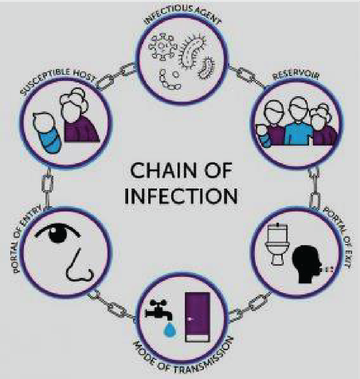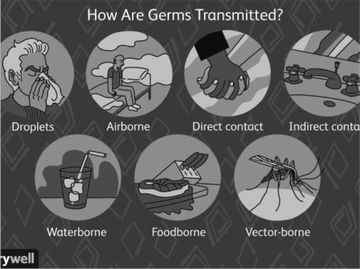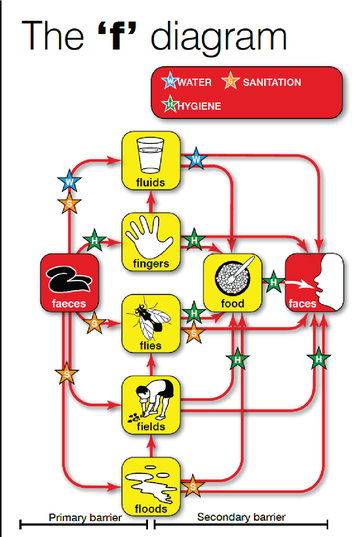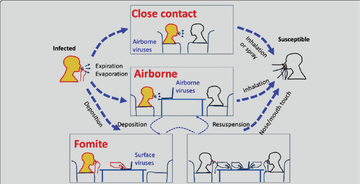Modes of Pathogen Transmission

To understand the transmission routes of pathogens and to identify how to prevent the transmission.

45 minutes

Presentations, group work

Audio-Visual, Posters, Infographics

Definitions to Note:
Routes:
Transmission:
Pathogens:
Microorganism:
Modes of Transmission:
Activity:
- Step 1: Brainstorm, in a group or by yourself, on the following question: 'How does the coronavirus transmits to human body?'
- Step 2: After 5 minutes, draw out the transmission route of the coronavirus or any other pathogen like Diarrhoea.
- Step 3: Try and enrich your routes using the guiding images below.
- Step 4: After completing the task, share your reflections with your group.



Information to Guide the Discussions:
How germs are spread is a key factor in preventing disease, and it varies for different bacteria, viruses, and other pathogens.
- In some cases, you may have to come in direct contact with an infected person to be infected.
- In others, the germ may be aerosolized (say, when someone sneezes) and find its way into your body when you simply take a breath.
- By understanding these and other modes of germ transmission, you can protect your health and that of the people around you
Read on to find the different modes of transmission in which the germs can spread:
- Contact: the most frequent mode of transmission of infections and can be divided into direct and indirect.
- Direct: involves direct body surface to body surface contact and physical transfer of microorganism between an infected or colonized (germs are on the body but do not make you sick) person to another person by touch.
- Indirect: involves contact between a person and a contaminated object.
- This is often a result of unclean hands contaminating an object or environment. The microorganism remains on this surface to be picked up by the next person who touches it.
- Droplet Transmission: this occurs when droplets containing microorganisms generated during coughing, sneezing and talking are propelled through the air. These microorganisms land on another person, entering that new person’s system through contact with his/her conjunctivae (membrane that lines the inner surface of the eyelid and also covers the front part of the eye), nasal mucosa (nasal cavity) or mouth.
- These microorganisms are relatively large and travel only short distances (up to 6 feet/2 metres).
- However, these infected droplets may linger on surfaces for long periods of time, so these surfaces (within the range of the coughing/sneezing person) will need additional cleaning.
- Examples of microorganisms that are spread by droplet transmission are: influenza, colds, respiratory syncytial virus (RSV) and some organisms causing pneumonia.
- Fecal-Oral Transmission: infectious faecal-oral diseases are spread when a susceptible person (or in some cases, an animal) ingests a pathogen that gives them the disease. The pathogen multiples inside them and is then found in their faeces (excrement).
- Excreta-related (also known as waste matter, such as urine, faeces, or sweat, discharged from the body) water-borne diseases can be transmitted by any route which allows faecal matter to enter the mouth; the faecal-oral route.
- In 1958, Wagner and Lanoix identified the major means of transmission and produced what is now known as the ‘f’ diagram:

- This diagram illustrates the main means of transmission, through:
- fluids (drinking water)
- food,
- flies,
- fields (crops and soil),
- floors,
- fingers and,
- floods (and surface water generally).
- There can be other associated routes such as drinking water that may be contaminated by a dirty water container, for example, or food may be infected by dirty cooking utensils.
Source: https://wedc-knowledge.lboro.ac.uk/resources/e/mn/018-Preventing-the-transmission-of-faecal-oral-diseases.pdf
- Airborne Transmission: occurs either by:
- Airborne droplet nuclei (small particles of 5 mm or smaller in size)
- Dust particles containing infectious agents.
- In airborne transmission, a virus or bacteria is able to remain in the air for a long period of time, be distributed by airflow, and be inhaled.
- Germs capable of airborne transmission can reach the lower respiratory tract when inhaled. It may not take many germs for an infection to occur.
- Fomite Transmission: applies to microorganisms that are transmitted by contaminated items such as food, water, medications, medical devices and equipment.
- Vector-Borne Transmission: mosquitoes, ticks, rats, dogs, and other animals can transmit some disease-causing germs to humans.
- In these cases, the germ must pass through the animal host before it can infect humans, such as with malaria. However, the germ doesn't always have to be inside the vector—rather, it may be adhered to the outside of the vector's body, though this is not the usual scenario with vector-borne disease.
- In cases like malaria, it may be possible to control the spread by eliminating the mosquito vector. In others, including tick-borne Lyme disease and Rocky Mountain spotted fever, it is best to avoid the vector.
- Vaccination of dogs and cats can prevent the spread of rabies.
Here is a diagram that summarizes all that you have learned above:

Average Rating: ☆ ☆ ☆ ☆ ☆ (0 reviews)

